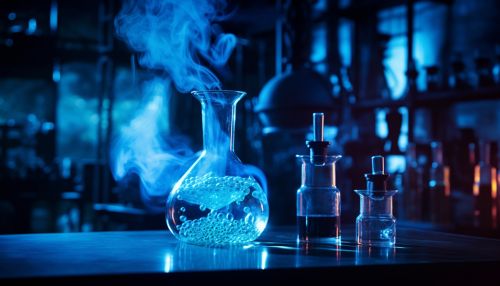Chemiluminescence
Introduction
Chemiluminescence is a process by which light is emitted from a chemical reaction. The phenomenon occurs when a chemical reaction results in an excited state species which can then decay to a lower energy level by emitting a photon. This process is different from fluorescence or phosphorescence, where light is first absorbed and then re-emitted.


Mechanism of Chemiluminescence
The mechanism of chemiluminescence involves the production of an electronically excited species during a chemical reaction. This excited species can then emit light as it returns to its ground state. The general mechanism can be divided into three steps: initiation, propagation, and termination.
Initiation
During the initiation step, a chemical reaction produces an electronically excited species. This can occur through a variety of reaction types, including redox reactions, nucleophilic substitutions, and elimination reactions. The specific reaction depends on the chemicals involved.
Propagation
In the propagation step, the excited species can undergo further reactions. These reactions can either produce more excited species, leading to a chain reaction, or they can produce stable products. The propagation step is often the source of the light emission in chemiluminescence.
Termination
The termination step occurs when the excited species returns to its ground state, emitting a photon in the process. The wavelength of the emitted light is determined by the energy difference between the excited state and the ground state.
Types of Chemiluminescence
There are several types of chemiluminescence, including liquid-phase chemiluminescence, gas-phase chemiluminescence, and solid-state chemiluminescence. Each type has its own unique characteristics and applications.
Liquid-phase Chemiluminescence
Liquid-phase chemiluminescence occurs in liquid solutions. This is the most common type of chemiluminescence and is often used in analytical chemistry for the detection of various substances. Examples of liquid-phase chemiluminescence include the luminol reaction and the peroxidase reaction.
Gas-phase Chemiluminescence
Gas-phase chemiluminescence occurs in gaseous systems. This type of chemiluminescence is often observed in atmospheric chemistry and combustion processes. An example of gas-phase chemiluminescence is the light produced by a Bunsen burner.
Solid-state Chemiluminescence
Solid-state chemiluminescence occurs in solid materials. This type of chemiluminescence is less common but has been observed in certain materials, such as phosphorus and zinc sulfide.
Applications of Chemiluminescence
Chemiluminescence has a wide range of applications in various fields, including analytical chemistry, biochemistry, medical diagnostics, and environmental monitoring.
Analytical Chemistry
In analytical chemistry, chemiluminescence is used as a detection method for various substances. The sensitivity and selectivity of chemiluminescence make it a powerful tool for the detection of trace amounts of substances. Examples of substances that can be detected using chemiluminescence include metal ions, organic compounds, and biological molecules.
Biochemistry
In biochemistry, chemiluminescence is used in various assays and imaging techniques. For example, chemiluminescence is used in enzyme-linked immunosorbent assays (ELISAs) and Western blots for the detection of proteins. Chemiluminescence is also used in bioluminescence imaging for the visualization of biological processes in living organisms.
Medical Diagnostics
In medical diagnostics, chemiluminescence is used in various tests and assays. For example, chemiluminescence is used in immunoassays for the detection of various biomarkers. Chemiluminescence is also used in molecular diagnostics for the detection of genetic mutations and infectious diseases.
Environmental Monitoring
In environmental monitoring, chemiluminescence is used for the detection of various pollutants. For example, chemiluminescence is used for the detection of nitrogen oxides in the atmosphere and for the detection of pesticides in water.
